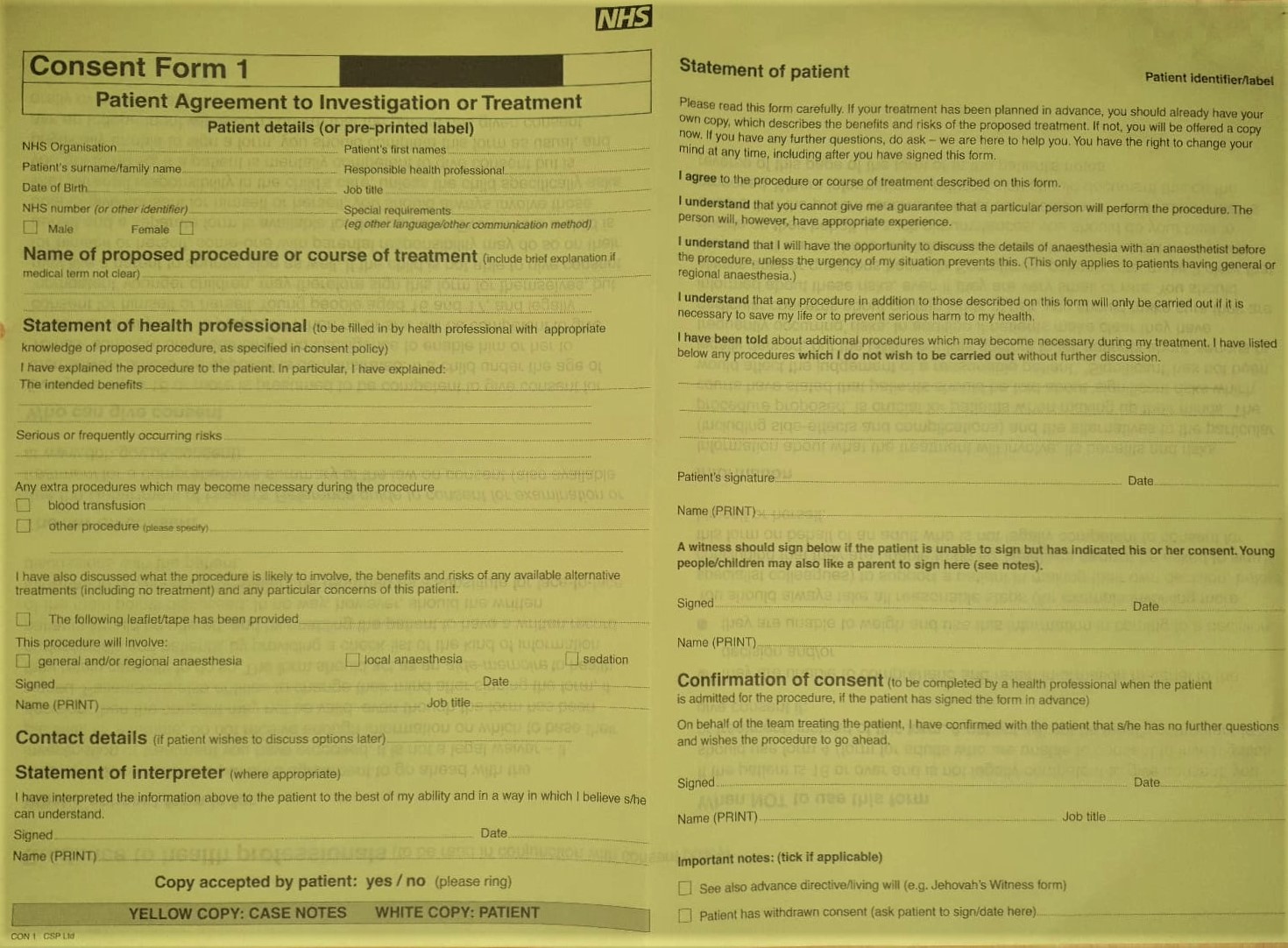For most planned medical procedures in the UK, you will be required to sign a consent form. This is to confirm your agreement to the procedure and that you understand its benefits and risks. This is often a generic paper form that may be handwritten with the details of your procedure (as shown below). In some institutions, procedure-specific, typed forms may be used. You might be asked to sign this in advance when first deciding to proceed for an operation (e.g. in clinic) or on the day of the procedure itself.
Consent Form 1

Consent form type
There are 4 main types of consent forms in the United Kingdom for medical or surgical procedures. Usually for adults who are able to make decisions themselves, this is called a Consent Form 1. Other consent forms apply to children and adults who are unable to make decisions for themselves.
Treatment
In this section, the medical professional will write the name of the proposed treatment, for example 'Left Total Hip Replacement'. This may often include medical words, shorthand or words that have specific meaning in the medical world and it is important for you to ask if any of these are unclear. For example if this said 'Bilateral Total Hip Replacement', the word 'Bilateral' would mean a plan to replace both hips.
Benefits
Here, the medical professional should list the intended benefit you may gain from the operation, and whether it is performed to learn more about what condition you have (Diagnosis) or to reduce the symptoms of a condition (Treatment). Sometimes a treatment may only have a chance of improving some of your symptoms, so do check with your clinician which symptoms might be improved, by how much and the chances of this happening.
Patient Details
Your clinician should double check with you that they have the correct details for you on this form. The 'Responsible health professional' is usually the consultant in charge of your care.
Risks
The risks of the procedure should be explained to you and summarised here. The exact risks will be unique for each patient and each operation. These may be written using medical terminology, so ask if any terms are unclear. The clinician should also be able to tell you how likely or severe these risks are, what impact they might have on you and what can be done about them if they occur, so do ask if you want to know this.
Blood transfusions
Some procedures may carry a high risk of bleeding, and you may be asked to consent in advance for blood transfusions might need when you are asleep. If there is a reason you would not want this, let your clinician know.
Other procedures
Sometimes, a clinician may have a 'Plan B'. This might include extra procedures that may need to be added whilst you are asleep and unable to discuss them. Your clinician should be able to tell you what the chances are of this happening, as well as the benefits and risks of this extra procedure.
Extra information
Detailed written information is available about procedures in print or online, and your clinician should be able to direct you to these. This website is just one example of where you might find this information.
Anaesthesia
"Anaesthesia" is the method of preventing unpleasant sensations and pain during procedures. If general anaesthetic or regional anaesthetic is being used, a specialised anaesthetic doctor will speak to you before the operation and can explain the risks of these. Local anaesthetic is often given by the clinician carrying out the procedure, and they should be able to explain what this involves. You can find out more about anaesthesia here: https://lnwh.operation-information.co.uk/anaesthesia/.
Clinician Signature
This is where the clinician discussing the consent form with you will sign. They may or may not be the clinician who will be carrying out the operation itself.
Interpreter
If an interpreter has been involved in this discussion, either in person or on the phone, their details may be put here. If you English is not your first language and you would like an interpreter to help you understand this discussion, do ask, as these are usually available by phone.
Copy of consent
These forms are copied on two layers, and the white layer can be given to you for your own records if you wish to keep it.
Declining other treatment
If there are potential extra treatments that have been discussed with you, that you do not want under any circumstances, you can list them here.
Patient signature
This is where you, as the patient, should sign and print your name, and write todays date.
Witness
If you are physically unable to sign the form, a witness (for example, a relative or friend) who has been present for the dicussion may sign on your behalf.
Confirmation
If you have signed the form in advance of the procedure date (for example in clinic), a clinician on the day may double check you are still happy to proceed. You do not need to sign the form again, but if you have any new questions or want anything repeated, do ask.
Statement of Patient
These are the terms you are agreeing to by signing the consent form, do read them and if you have any questions ask your clinician.
